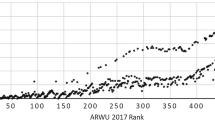Abstract
Some authors (including ourselves) have argued that the research quality of an individual or group has to be evaluated by peer review based on the originality, strength, reproducibility, and relevance of their publications. As a result, a reputation is built up by the community. In this article, we dwell on complementary indicators of a scientist performance—prolificacy and visibility—by critically analyzing a plethora of scientometric data for the hard sciences. Our investigation corroborates the notion that the H-indexes (which correlate to both prolificacy and visibility) of the most prolific and most cited researchers strongly depend on the field of study and increase with the total number of publications, N. Here we use the MZE-index (defined in a previous article) to distinguish the H-indexes of authors that stand at, above or below the average of their field for any number of publications. In addition, we propose a field normalization factor (FNF) which allows one to scale the H-indexes of any author or group belonging to different research fields. While neither the MZE nor FNF- normalized H indices can guarantee quality or reputation, they show how visible by their community a researcher, research group, or institution is. We also explore a potential correlation of prolificacy and visibility with scientific reputation by comparing the performances of the most cited scientists with those of the winners of important awards in five macro-areas of the hard sciences. This comparison reveals strongly field-dependent features, suggesting that citation-based parameters can be useful, complementary scientometric evaluators, but should not be confused with quality.






Similar content being viewed by others
References
Alonso, S., Cabrerizo, F. J., Herrera-Viedma, E., & Herrera, F. (2009). H-index: A review focused in its variants, computation and standardization for different scientific fields. Journal of Informetrics,3(4), 273–289.
Babić, D., Kutlača, Đ., Živković, L., Štrbac, D., & Semenčenko, D. (2016). Evaluation of the quality of scientific performance of the selected countries of Southeast Europe. Scientometrics,106(1), 405–434.
Claro, J., & Costa, C. (2011). A made-to-measure indicator for cross-disciplinary bibliometric ranking of researchers performance. Scientometrics,86(1), 113–123.
Egghe, L. (2010). The Hirsch index and related impact measures. Annual Review of Information Science and Technology,44(1), 65–114.
Hirsch, J. E. (2005). An index to quantify an individual’s scientific research output. Proceedings of the National Academy of Sciences of the United States of America,102(46), 16569–16572.
Iglesias, J. E., & Pecharromán, C. (2007). Scaling the H-index for different scientific ISI fields. Scientometrics,73(3), 303–320.
Ioannidis, J. P. A., Boyack, K., & Wouters, P. F. (2016). Citation metrics: A primer on how (not) to normalize. PLoS Biology,14(9), e1002542.
Ioannidis, J. P. A., Klavans, R., & Boyack, K. W. (2018). Thousands of scientists publish a paper every five days. Nature,561(7722), 167–169.
Liang, L. (2006). H-index sequence and h-index matrix: Constructions and applications. Scientometrics,69(1), 153–159.
Molinari, J. F., & Molinari, A. (2008). A new methodology for ranking scientific institutions. Scientometrics,75, 163–174.
Montazerian, M., Zanotto, E. D., & Eckert, H. (2017). Bibliometrics in glass and other sciences: A Plea for reason. International Journal of Applied Glass Science,8(3), 352–359.
Montazerian, M., Zanotto, E. D., & Eckert, H. (2019). A new parameter for (normalized) evaluation of H-index: Countries as a case study. Scientometrics,118(3), 1065–1078.
Namazi, M. R., & Fallahzadeh, M. K. (2010). N-index: A novel and easily-calculable parameter for comparison of researchers working in different scientific fields. Indian Journal of Dermatology, Venereology, and Leprology,76(3), 229–230.
Norris, M., & Oppenheim, C. (2010). The H-index: A broad review of a new bibliometric indicator. Journal of Documentation,66(5), 681–705.
Panaretos, J., & Malesios, C. (2009). Assessing scientific research performance and impact with single indices. Scientometrics,81(3), 635–670.
Radicchi, F., Fortunatoa, S., & Castellanob, C. (2008). Universality of citation distributions: Toward an objective measure of scientific impact. Proceedings of the National Academy of Sciences of the United States of America,105(45), 17268–17272.
Redner, S. (1998). How popular is your paper? An empirical study of the citation distribution. European Physical Journal B,4(2), 131–134.
Schubert, A., & Glänzel, W. (2007). A systematic analysis of Hirsch-type indices for journals. Journal of Informetrics,1(2), 179–184.
Sidiropoulos, A., Katsaros, D., & Manolopoulos, Y. (2007). Generalized Hirsch H-index for disclosing latent facts in citation networks. Scientometrics,72, 253–280.
Waltman, L. (2016). A review of the literature on citation impact indicators. Journal of Informetrics,10(2), 365–391.
Wildgaard, L., Schneider, J. W., & Larsen, B. (2014). A review of the characteristics of 108 author-level bibliometric indicators. Scientometrics,101(1), 125–158.
Ye, F. Y. (2011). A unification of three models for the H-index. Journal of the American Society for Information Science and Technology,62(1), 205–220.
Zanotto, E. D. (2006). The scientists pyramid. Scientometrics,69(1), 175–181.
Acknowledgements
The authors are grateful to CNPq and to the São Paulo Research Foundation (FAPESP, # 2013/07793-6)—CEPID/CeRTEV—for financial support of this work and the post-doctoral fellowship granted to Maziar Montazerian (# 2015/13314-9).
Author information
Authors and Affiliations
Corresponding author
Electronic supplementary material
Below is the link to the electronic supplementary material.
Rights and permissions
About this article
Cite this article
Montazerian, M., Zanotto, E.D. & Eckert, H. Prolificacy and visibility versus reputation in the hard sciences. Scientometrics 123, 207–221 (2020). https://doi.org/10.1007/s11192-020-03369-w
Received:
Published:
Issue Date:
DOI: https://doi.org/10.1007/s11192-020-03369-w
Keywords
Profiles
- Edgar Dutra Zanotto View author profile



